Sustainable Spatial Energy Planning of Large-Scale Wind and PV Farms in Israel: A Collaborative and Participatory Planning Approach
Abstract
1. Introduction
2. Overview of the Sustainable Spatial Energy Planning Framework
3. The Planning Module
3.1. Definition of SC and Data Collection/Digitization (Step 1)
3.2. Development of a RES GIS Database (Step 2)
3.3. Local Public and Local Experts’ Participation in the Site-Selection Processes (Step 3)
3.3.1. Local Public Participation in the Site-Selection Processes
3.3.2. Local Experts’ Participation in the Site-Selection Processes
3.4. Determination of Appropriate Sites (Step 4)
3.5. Determination of SI of the Appropriate Sites (Step 5)
3.5.1. Definition of AC
3.5.2. Inclusion of AC Importance by Each Participatory Group
3.5.3. Site Suitability Analysis
4. The Field Investigation Module (Step 6)
5. Results and Discussion
5.1. Creation of SC Thematic Maps
5.2. Insights from the Local Public Participatory Process
5.3. Determination of Appropriate Sites
5.4. Site Suitability Analyses’ Results
5.5. Field Investigation Results
6. Conclusions
- An extremely high, unexploited up to now, solar energy potential in Israel has been highlighted.
- The citizens’ negative attitude towards the deployment of wind energy projects in Israel may be related to the fact that the existing nowadays relevant projects in the country do not comply with the restrictions of the proposed in this paper SSEP.
- The national RES GIS database developed in the present paper can contribute to an accelerated development of RES in Israel.
- The involvement of different participatory groups (e.g., experts and public) into the spatial planning process has revealed the potential to exploit the experts’ high knowledge and valuable experience by understanding/acknowledging at the same time the public concerns; hence, the aforementioned involvement can significantly boost the deployment of wind and solar energy projects.
- The existence of high suitable sites for large-scale WFs’ and PVFs’ siting in Israel illustrates that large-scale RES projects have the potential to contribute effectively towards the fulfillment of the national energy targets in the near future.
- The results of the present paper could be further utilized within the context of creating a national energy roadmap in Israel.
Author Contributions
Funding
Acknowledgments
Conflicts of Interest
Abbreviations
Appendix A
Appendix B
References
- REN21. Renewables 2020 Global Status Report; REN21 Secretariat: Paris, France, 2020. [Google Scholar]
- REN21. Renewables 2019 Global Status Report; REN21 Secretariat: Paris, France, 2019. [Google Scholar]
- Lee, J.; Zhao, F. Global Wind Report 2019; Global Wind Energy Council: Brussels, Belgium, 2020. [Google Scholar]
- IEA PVPS TCP. Snapshot of Global PV Markets 2020; The International Energy Agency (IEA): Paris, France, 2020. [Google Scholar]
- Environmental Protection Minister Gila Gamliel: Govt. Decision to Have 30% Renewables by 2030 Isn’t Ambitious Enough. Available online: https://www.gov.il/en/departments/news/gamliel_says_30_percent_renewables_by_2030_not_ambitious_enough (accessed on 18 December 2020).
- Electricity Authority: Renewable Energy Market Momentum in Israel—A Swing Market. Available online: https://www.gov.il/he/departments/news/new_energy_19102020 (accessed on 18 December 2020).
- Höfer, T.; Sunak, Y.; Siddique, H.; Madlener, R. Wind farm siting using a spatial Analytic Hierarchy Process approach: A case study of the Städteregion Aachen. Appl. Energy 2016, 163, 222–243. [Google Scholar] [CrossRef]
- Ramirez-Rosado, I.J.; Garcia-Garrido, E.; Fernandez-Jimenez, A.; Zorzano-Santamaria, P.J.; Monteiro, C.; Miranda, V. Promotion of new wind farms based on a decision support system. Renew. Energy 2008, 33, 558–566. [Google Scholar] [CrossRef]
- Latinopoulos, D.; Kechagia, K. A GIS-based multi-criteria evaluation for wind farm site selection. A regional scale application in Greece. Renew. Energy 2015, 78, 550–560. [Google Scholar] [CrossRef]
- Haaren, R.V.; Fthenakis, V. GIS-based wind farm site selection using spatial multi-criteria analysis (SMCA): Evaluating the case for New York State. Renew. Sustain. Energy Rev. 2011, 15, 3332–3340. [Google Scholar] [CrossRef]
- Baseer, M.A.; Rehman, S.; Meyer, J.P.; Mahbub Alam, Md. GIS-based site suitability analysis for wind farm development in Saudi Arabia. Energy 2017, 141, 1166–1176. [Google Scholar] [CrossRef]
- Siyal, S.H.; Mörtberg, U.; Mentis, D.; Welsch, M.; Babelon, I.; Howells, M. Wind energy assessment considering geographic and environmental restrictions in Sweden: A GIS-based approach. Energy 2015, 83, 447–461. [Google Scholar] [CrossRef]
- Bennui, A.; Rattanamanee, P.; Puetpaiboon, U.; Phukpattaranont, P.; Chetpattananondh, K. Site selection for large wind turbine using GIS. In Proceedings of the 3rd International Conference on Engineering and Environment, Phuket, Thailand, 10–11 May 2007. [Google Scholar]
- Georgiou, A.; Polatidis, H.; Haralambopoulos, D. Wind Energy Resource Assessment and Development: Decision Analysis for Site Evaluation and Application. Energy Source. Part A 2012, 34, 1759–1767. [Google Scholar] [CrossRef]
- Noorollahi, Y.; Itoi, R.; Fujii, H.; Tanaka, T. GIS integration model for geothermal exploration and well siting. Geothermics 2008, 37, 107–131. [Google Scholar] [CrossRef]
- Tegou, L.-I.; Polatidis, H.; Haralambopoulos, D.A. Environmental management framework for wind farm siting: Methodology and case study. J. Environ. Manag. 2010, 91, 2134–2147. [Google Scholar] [CrossRef]
- Bili, A.; Vagiona, D.G. Use of multicriteria analysis and GIS for selecting sites for onshore wind farms: The case of Andros Island (Greece). Eur. J. Environ. Sci. 2018, 8, 5–13. [Google Scholar] [CrossRef]
- Panagiotidou, M.; Xydis, G.; Koroneos, C. Environmental Siting Framework for Wind Farms: A Case Study in the Dodecanese Islands. Resources 2016, 5, 24. [Google Scholar] [CrossRef]
- Sarpong, D.; Baffoe, P.E. Selecting Suitable Sites for Wind Energy Development in Ghana. Ghana Min. J. 2016, 16, 8–20. [Google Scholar]
- Ayodele, T.R.; Ogunjuyigbe, A.S.O.; Odigie, O.; Munda, J.L. A multi-criteria GIS based model for wind farm site selection using interval type-2 fuzzy analytic hierarchy process: The case study of Nigeria. Appl. Energy 2018, 228, 1853–1869. [Google Scholar] [CrossRef]
- Harper, M.; Anderson, B.; James, P.; Bahaj, A. Identifying suitable locations for onshore wind turbines using a GIS-MCDA approach. In Proceedings of the 17th International Conference on Sustainable Energy Technologies, Bologna, Italy, 17–20 July 2017. [Google Scholar]
- Tsoutsos, T.; Tsitoura, I.; Kokologos, D.; Kalaitzakis, K. Sustainable siting process in large wind farms case study in Crete. Renew. Energy 2015, 75, 474–480. [Google Scholar] [CrossRef]
- Sánchez-Lozano, J.M.; García-Cascales, M.S.; Lamata, M.T. Identification and selection of potential sites for onshore wind farms development in Region of Murcia, Spain. Energy 2014, 73, 311–324. [Google Scholar] [CrossRef]
- Al Garni, H.Z.; Awasthi, A. Solar PV power plant site selection using a GIS-AHP based approach with application in Saudi Arabia. Appl. Energy 2017, 206, 1225–1240. [Google Scholar] [CrossRef]
- Sánchez-Lozano, J.M.; Teruel-Solano, J.; Soto-Elvira, P.L.; García-Cascales, M.S. Geographical Information Systems (GIS) and Multi-Criteria Decision Making (MCDM) methods for the evaluation of solar farms locations: Case study in south-eastern Spain. Renew. Sustain. Energy Rev. 2013, 24, 544–556. [Google Scholar] [CrossRef]
- Sánchez-Lozano, J.M.; García-Cascales, M.S.; Lamata, M.T. Comparative TOPSIS-ELECTRE TRI methods for optimal sites for photovoltaic solar farms. Case study in Spain. J. Clean. Prod. 2016, 127, 387–398. [Google Scholar] [CrossRef]
- Charabi, Y.; Gastli, A. PV site suitability analysis using GIS-based spatial fuzzy multi-criteria evaluation. Renew. Energy 2011, 36, 2554–2561. [Google Scholar] [CrossRef]
- Hott, R.; Santini, R.; Brownson, J. GIS-based spatial analysis for large-scale solar power and transmission line issues: Case study of Wyoming, U.S. In Proceedings of the 41st American Solar Energy Society Meeting, Denver, CO, USA, 13–17 May 2012. [Google Scholar]
- Asakereh, A.; Soleymani, M.; Sheikhdavoodi, M.J. A GIS-based Fuzzy-AHP method for the evaluation of solar farms locations: Case study in Khuzestan province, Iran. Sol. Energy 2017, 155, 342–353. [Google Scholar] [CrossRef]
- Merrouni, A.A.; Elalaoui, F.E.; Mezrhab, A.; Mezrhab, A.; Ghennioui, A. Large scale PV sites selection by combining GIS and Analytical Hierarchy Process. Case study: Eastern Morocco. Renew. Energy 2018, 119, 863–873. [Google Scholar] [CrossRef]
- Tahri, M.; Hakdaoui, M.; Maanan, M. The evaluation of solar farm locations applying Geographic Information System and Multi-Criteria Decision-Making methods: Case study in southern Morocco. Renew. Sustain. Energy Rev. 2015, 51, 1354–1362. [Google Scholar] [CrossRef]
- Merrouni, A.A.; Mezrhab, A.; Mezrhab, A. PV sites suitability analysis in the Eastern region of Morocco. Sustain. Energy Technol. Assess. 2016, 18, 6–15. [Google Scholar] [CrossRef]
- Doorga, J.R.S.; Rughooputh, S.D.D.V.; Boojhawon, R. Multi-criteria GIS-based modelling technique for identifying potential solar farm sites: A case study in Mauritius. Renew. Energy 2019, 133, 1201–1219. [Google Scholar] [CrossRef]
- Majumdar, D.; Pasqualetti, M.J. Analysis of land availability for utility-scale power plants and assessment of solar photovoltaic development in the state of Arizona, USA. Renew. Energy 2019, 134, 1213–1231. [Google Scholar] [CrossRef]
- Gastli, A.; Charabi, Y. Siting of Large PV Farms in Al-Batinah Region of Oman. In Proceedings of the 2010 IEEE International Energy Conference, Manama, Bahrain, 18–22 December 2010. [Google Scholar]
- Georgiou, A.; Skarlatos, D. Optimal site selection for sitting a solar park using multi-criteria decision analysis and geographical information systems. Geosci. Instrum. Meth. 2016, 5, 321–332. [Google Scholar] [CrossRef]
- Doljak, D.; Stanojevic, G. Evaluation of natural conditions for site selection of ground-mounted photovoltaic power plants in Serbia. Energy 2017, 127, 291–300. [Google Scholar] [CrossRef]
- Khan, G.; Rathi, S. Optimal Site Selection for Solar PV Power Plant in an Indian State Using Geographical Information System (GIS). Int. J. Emerg. Eng. Res. Tech. 2014, 2, 260–266. [Google Scholar]
- Noorollahi, E.; Fadai, D.; Shirazi, M.A.; Ghodsipour, S.H. Land Suitability Analysis for Solar Farms Exploitation Using GIS and Fuzzy Analytic Hierarchy Process (FAHP)—A Case Study of Iran. Energies 2016, 9, 643. [Google Scholar] [CrossRef]
- Al-Shammari, S.; Ko, W.; Al Ammar, E.A.; Alotaibi, M.A.; Choi, H.-J. Optimal Decision-Making in Photovoltaic System Selection in Saudi Arabia. Energies 2021, 14, 357. [Google Scholar] [CrossRef]
- Welder, L.; Ryberg, D.S.; Kotzur, L.; Grube, T.; Robinius, M.; Stolten, D. Spatio-Temporal Optimization of a Future Energy System for Power-to-Hydrogen Applications in Germany. Energy 2018, 158, 1130–1149. [Google Scholar] [CrossRef]
- Mancini, F.; Nastasi, B. Solar Energy Data Analytics: PV Deployment and Land Use. Energies 2020, 13, 417. [Google Scholar] [CrossRef]
- Ali, S.; Taweekun, J.; Techato, K.; Waewsak, J.; Gyawali, S. GIS based site suitability assessment for wind and solar farms in Songkhla, Thailand. Renew. Energy 2019, 132, 1360–1372. [Google Scholar] [CrossRef]
- Janke, J.R. Multicriteria GIS modeling of wind and solar farms in Colorado. Renew. Energy 2010, 35, 2228–2234. [Google Scholar] [CrossRef]
- Watson, J.J.W.; Hudson, M.D. Regional Scale wind farm and solar farm suitability assessment using GIS-assisted multi-criteria evaluation. Landsc. Urban Plan. 2015, 138, 20–31. [Google Scholar] [CrossRef]
- Sadeghi, M.; Karimi, M. GIS-based solar and wind turbine site selection using multi-criteria analysis: Case study Tehran, Iran. Int. Arch. Photogramm. Remote Sens. Spatial Inf. Sci. 2017, XLII-4/W4, 469–476. [Google Scholar] [CrossRef]
- Munda, G. Social Multi-Criteria Evaluation for a Sustainable Economy; Springer: Berlin, Germany, 2008. [Google Scholar]
- Israeli Ministry of Interior. Photovoltaic Facilities. In National Outline Plan 1 (TAMA 1) Instructions; Israeli Ministry of Interior: Jerusalem, Israel, 2020; pp. 46–57. [Google Scholar]
- Israeli Ministry of Interior. Beaches. In National Outline Plan 1 (TAMA 1) Instructions; Israeli Ministry of Interior: Jerusalem, Israel, 2020; pp. 124–133. [Google Scholar]
- Israeli Ministry of Interior. National Outline Plan 10\D\12 for Wind Turbines (TAMA 10\D\12); Israeli Ministry of Interior: Jerusalem, Israel, 2014; p. 98.
- Israeli Ministry of Interior. National Outline Plan 10\D\10 for Photovoltaic Facilities (TAMA 10\D\10); Israeli Ministry of Interior: Jerusalem, Israel, 2010; p. 26.
- Global Wind Atlas: Israel. Available online: https://globalwindatlas.info/area/Israel (accessed on 10 January 2020).
- European Commission Joint Research Centre: Photovoltaic Geographical Information System. Available online: https://re.jrc.ec.europa.eu/pvg_tools/en/tools.html (accessed on 11 October 2019).
- NASA: POWER Data Access Viewer. Available online: https://power.larc.nasa.gov/data-access-viewer/ (accessed on 11 October 2019).
- Japan Aerospace Exploration Agency: Digital Surface Model. Available online: https://www.eorc.jaxa.jp/ALOS/en/aw3d30/data/html_v1903/n020e030_n050e060.htm (accessed on 17 September 2019).
- Tel Aviv University. Available online: https://english.tau.ac.il/ (accessed on 13 November 2019).
- Planning Director—Available Planning: List of District Outline Plans. Available online: http://mavat.moin.gov.il/MavatPS/Forms/SV9.aspx?tid=92&esid=20 (accessed on 13 November 2019).
- OSM: Geofabrik Download Server. Available online: https://download.geofabrik.de/asia/israel-and-palestine.html (accessed on 17 September 2019).
- UNESCO World Heritage Centre: Israel. Available online: https://whc.unesco.org/en/statesparties/il/ (accessed on 17 September 2019).
- Basemaps for ArcGIS Pro, Esri. Available online: https://pro.arcgis.com/en/pro-app/help/mapping/map-authoring/author-a-basemap.htm (accessed on 14 November 2019).
- Israel Nature and Parks Authority: National Parks and Nature Reserves. Available online: https://www.parks.org.il/en/ (accessed on 29 October 2019).
- Israel Airports Authority: Airports and Terminals (Maps and Lists). Available online: https://www.iaa.gov.il/en-US/rashot/Pages/default.aspx (accessed on 19 September 2019).
- Aircraft Charter World: Airports in Israel. Available online: http://www.aircraft-charter-world.com/airports/middleeast/israel.htm (accessed on 24 September 2019).
- Maritime Boundaries: Query Database. Available online: https://www.marineregions.org/eezsearch.php (accessed on 25 September 2019).
- Saaty, T.L. The Analytic Hierarchy Process; McGraw-Hill: New York, NY, USA, 1980. [Google Scholar]
- Saaty, T.L. Axiomatic Foundation of the Analytic Hierarchy Process. Manag. Sci. 1986, 32, 841–855. [Google Scholar] [CrossRef]
- Saaty, R.W. The analytic hierarchy process—What it is and how it is used. Math. Model. 1987, 9, 161–176. [Google Scholar] [CrossRef]
- Forman, E.; Peniwati, K. Aggregating individual judgments and priorities with the analytic hierarchy process. Eur. J. Oper. Res. 1998, 108, 165–169. [Google Scholar] [CrossRef]
- Ramanathan, R.; Ganesh, L.S. Group preference aggregation methods employed in AHP: An evaluation and an intrinsic process for deriving members’ weightages. Eur. J. Oper. Res. 1994, 79, 249–265. [Google Scholar] [CrossRef]
- Hwang, C.L.; Yoon, K. Multiple Attribute Decision Making: Methods and Applications; Springer: New York, NY, USA, 1981. [Google Scholar]
- Hwang, C.-L.; Lai, Y.-J.; Liu, T.-Y. A new approach for multiple objective decision making. Comput. Oper. Res. 1993, 20, 889–899. [Google Scholar] [CrossRef]
- Langer, K.; Decker, T.; Menrad, K. Public participation in wind energy projects located in Germany: Which form of participation is the key to acceptance? Renew. Energy 2017, 112, 63–73. [Google Scholar] [CrossRef]
- Jami, A.A.; Walsh, P.R. The Role of Public Participation in Identifying Stakeholder Synergies in Wind Power Project Development: The Case Study of Ontario, Canada. Energy 2014, 68, 194–202. [Google Scholar] [CrossRef]
- Geißler, G.; Köppel, J.; Gunther, P. Wind Energy and Environmental Assessments—A Hard Look at Two Forerunners’ Approaches: Germany and the United States. Renew. Energy 2013, 51, 71–78. [Google Scholar] [CrossRef]
- Huld, T.; Amillo, A.M.G. Estimating PV module performance over large geographical regions: The role of irradiance, air temperature, wind speed and solar spectrum. Energies 2015, 8, 5159–5181. [Google Scholar] [CrossRef]
- Yelmen, B.; Çakir, M.T. Influence of temperature changes in various regions of Turkey on powers of photovoltaic solar panels. Energy Source Part A 2016, 38, 542–550. [Google Scholar] [CrossRef]
- Giamalaki, M.; Tsoutsos, T. Sustainable siting of solar power installations in Mediterranean using a GIS/AHP approach. Renew. Energy 2019, 141, 64–75. [Google Scholar] [CrossRef]
- Chaouachi, A.; Covrig, C.F.; Ardelean, M. Multi-criteria selection of offshore wind farms: Case study for the Baltic States. Energy Policy 2017, 103, 179–192. [Google Scholar] [CrossRef]
- Gorsevski, P.V.; Cathcart, S.C.; Mirzaei, G.; Jamali, M.M.; Ye, X.; Gomezdelcampo, E. A group-based spatial decision support system for wind farm site selection in Northwest Ohio. Energy Policy 2013, 55, 374–385. [Google Scholar] [CrossRef]
- Spyridonidou, S.; Vagiona, D.G.; Loukogeorgaki, E. Strategic Planning of Offshore Wind Farms in Greece. Sustainability 2020, 12, 905. [Google Scholar] [CrossRef]
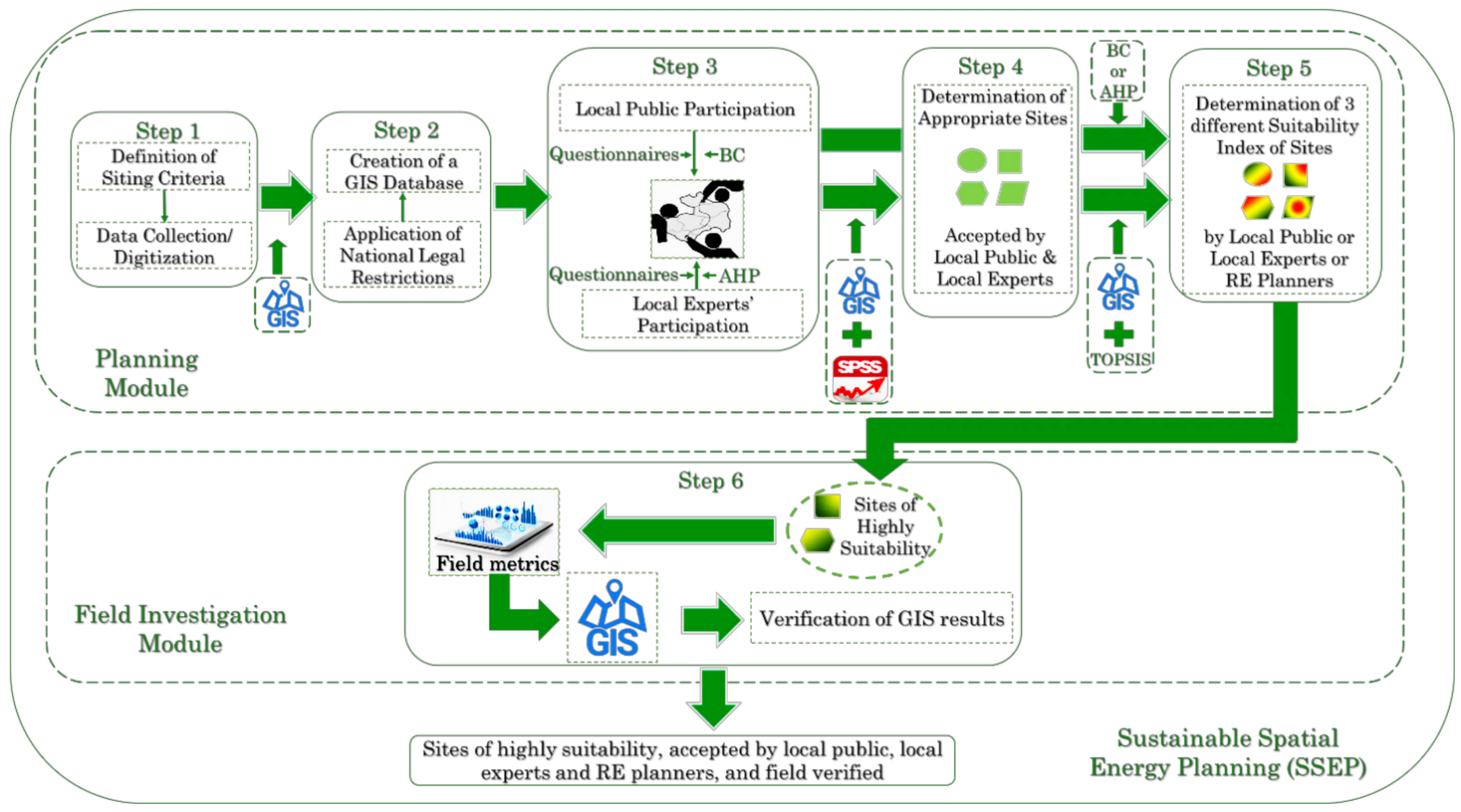
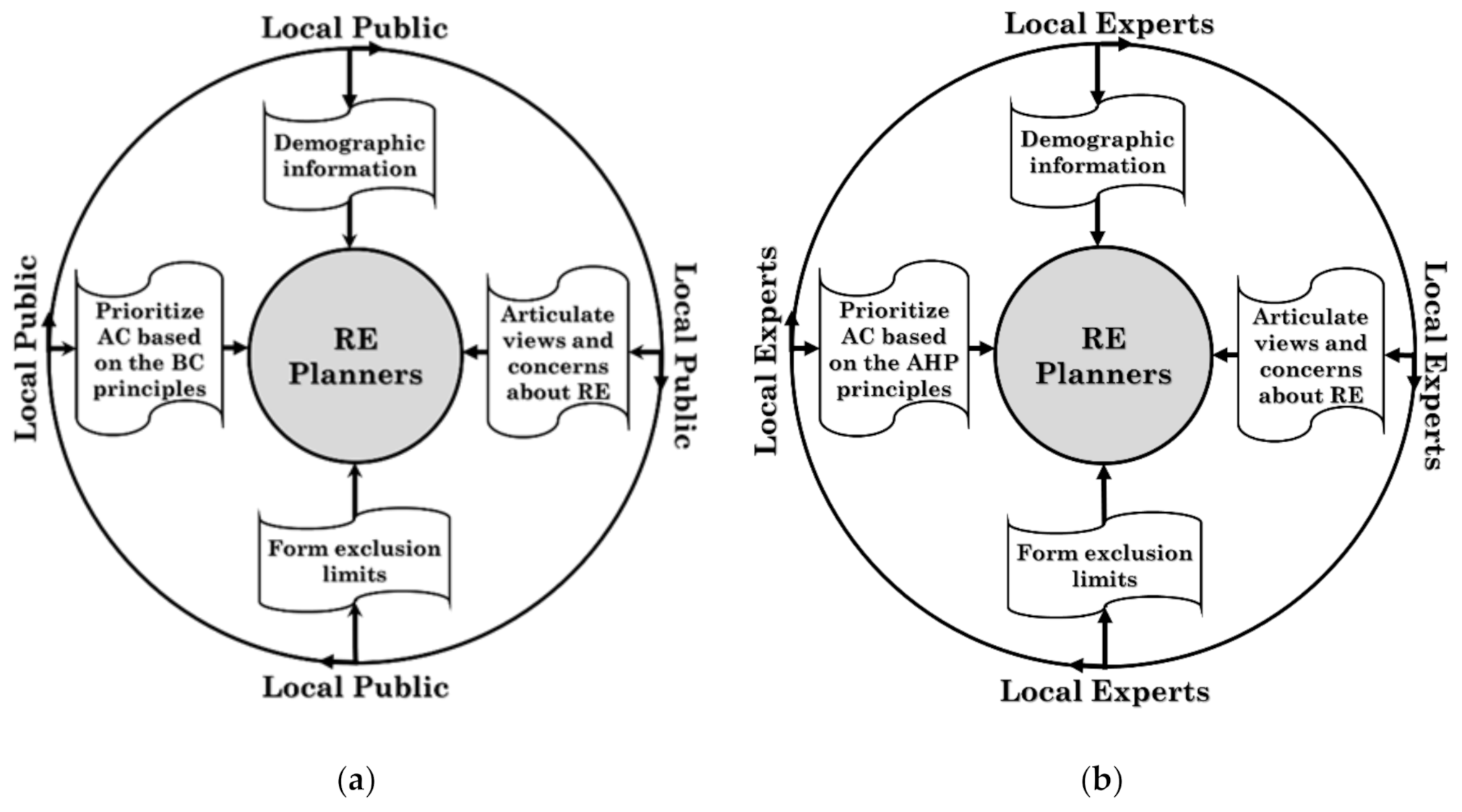
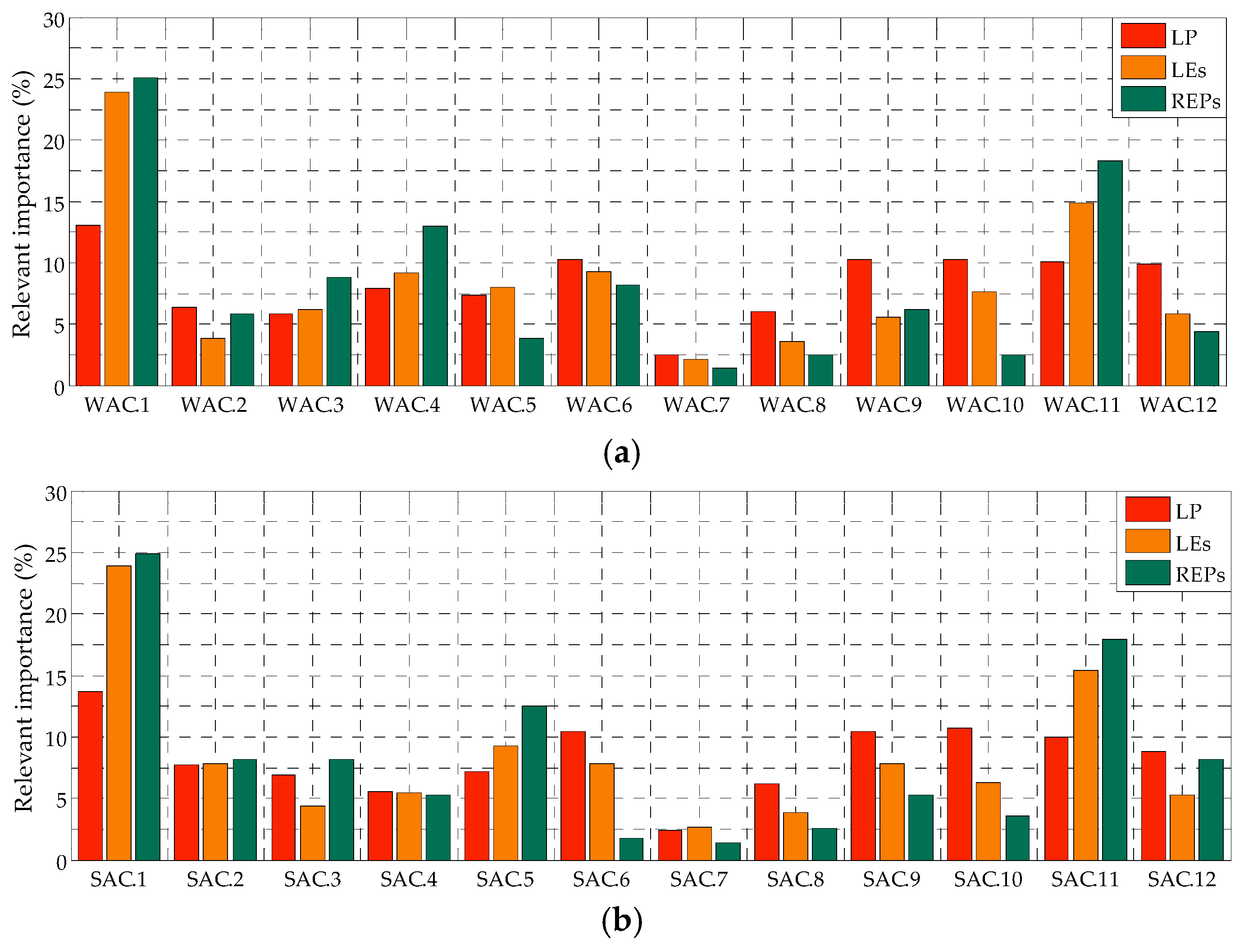

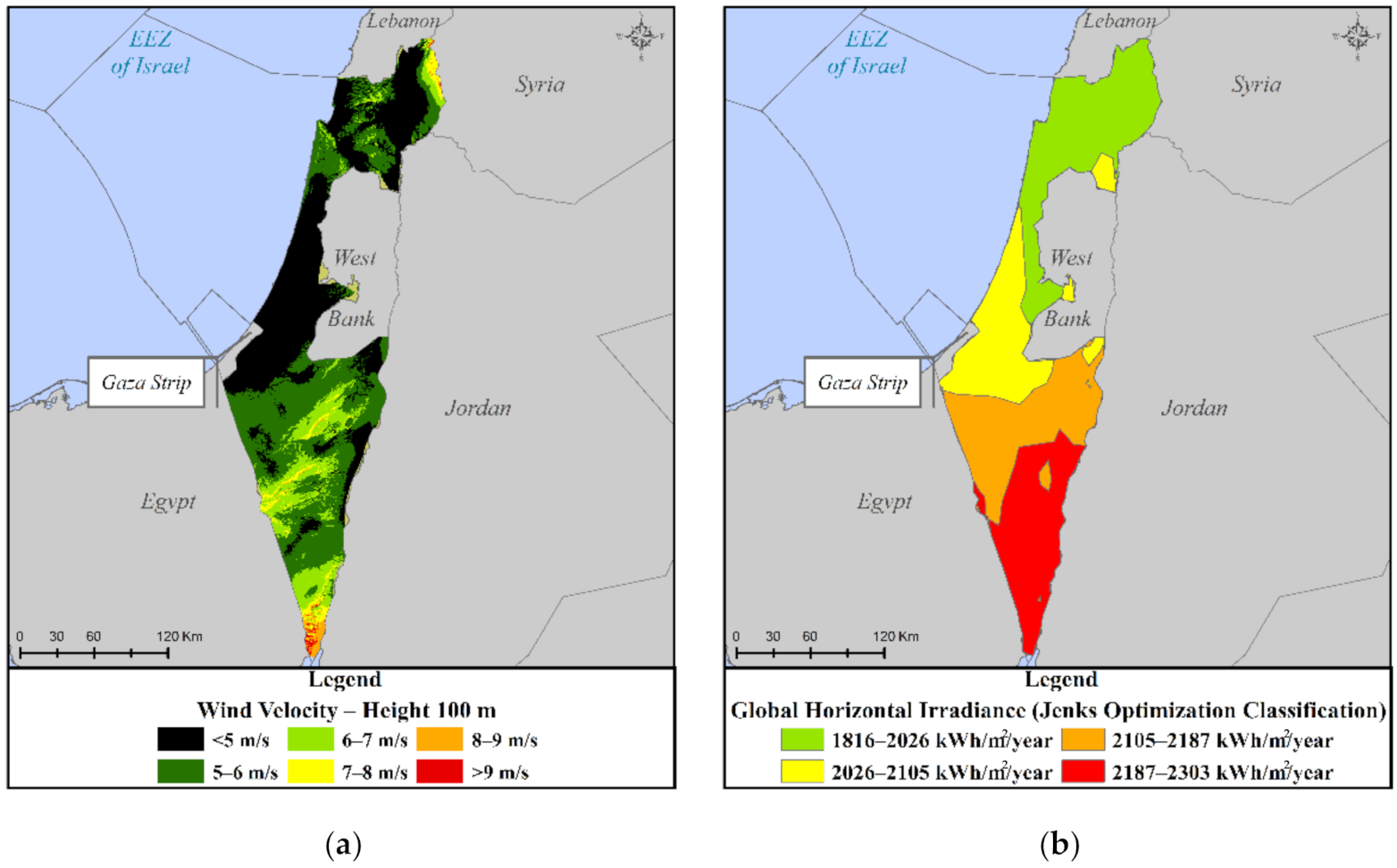
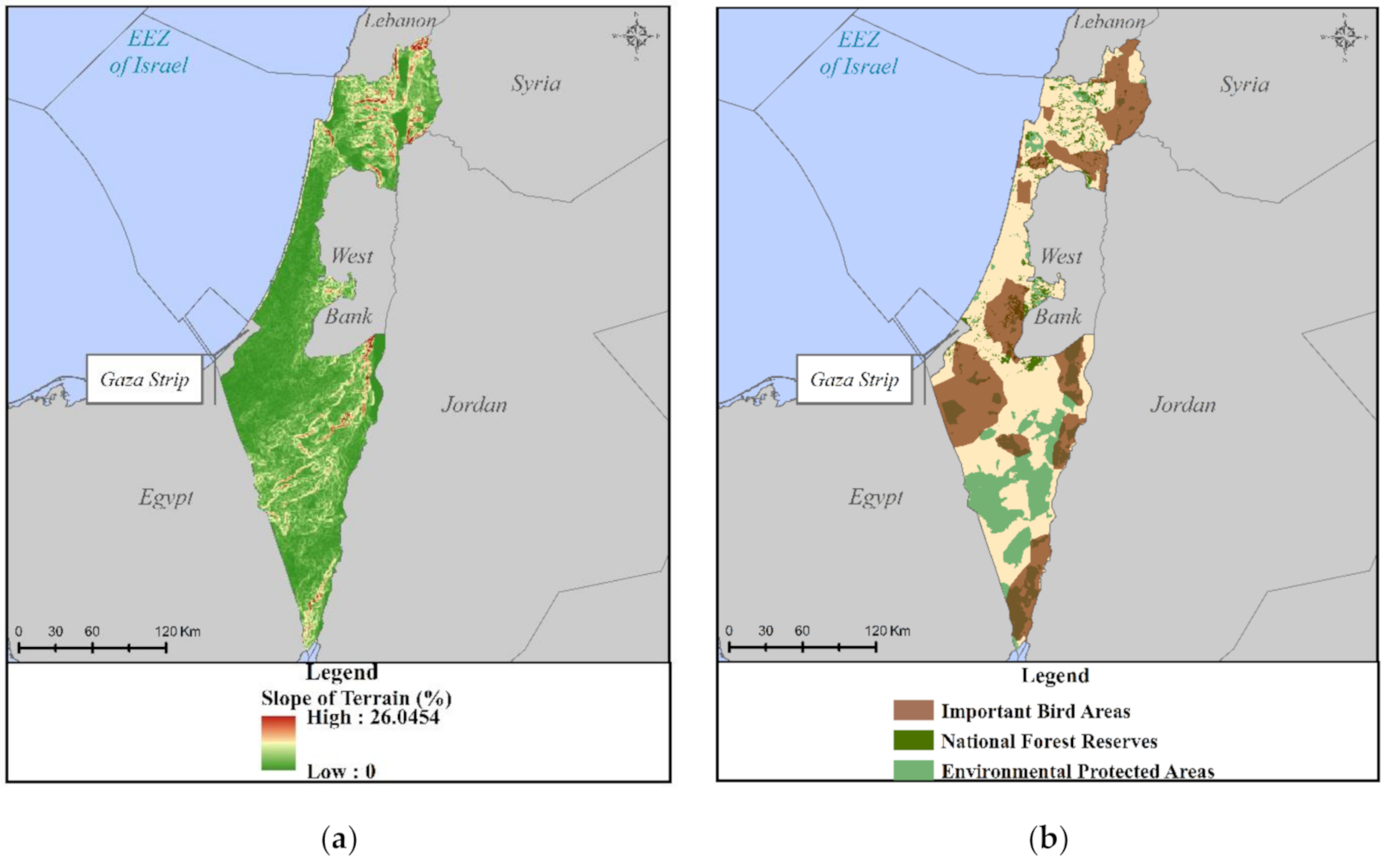
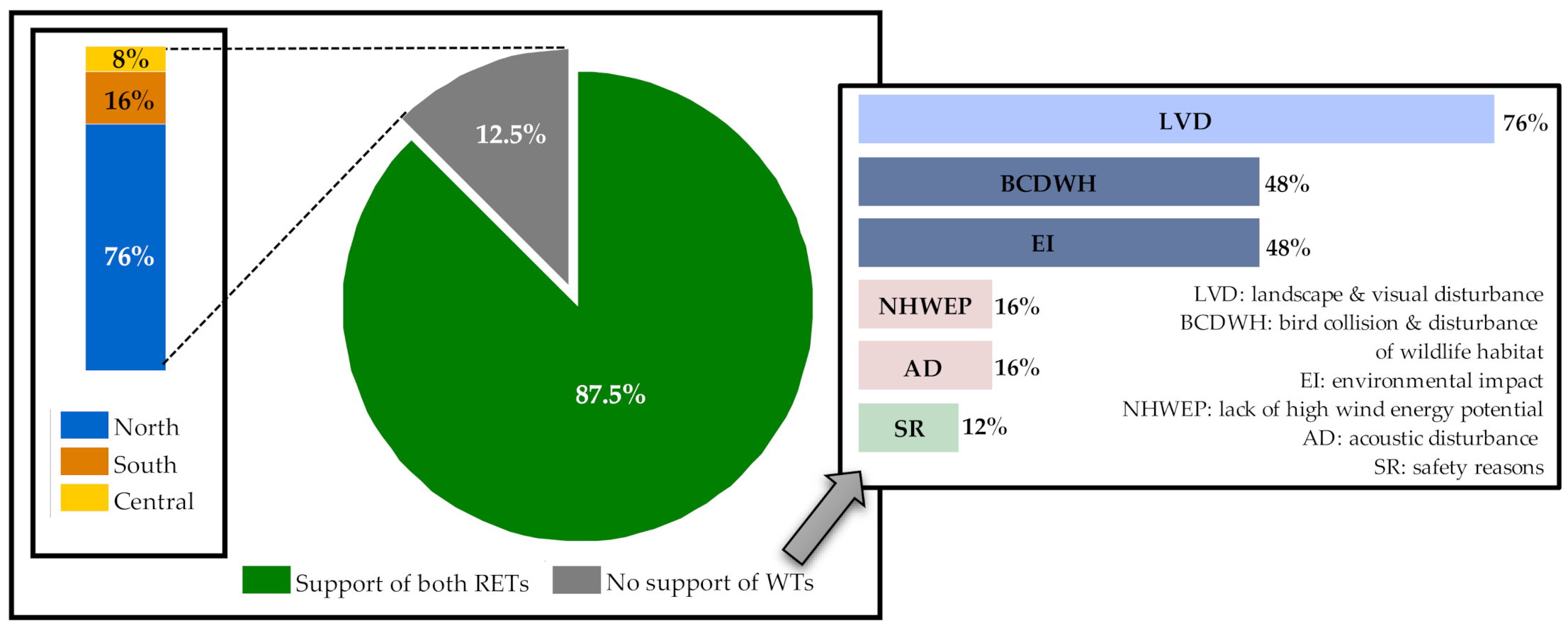
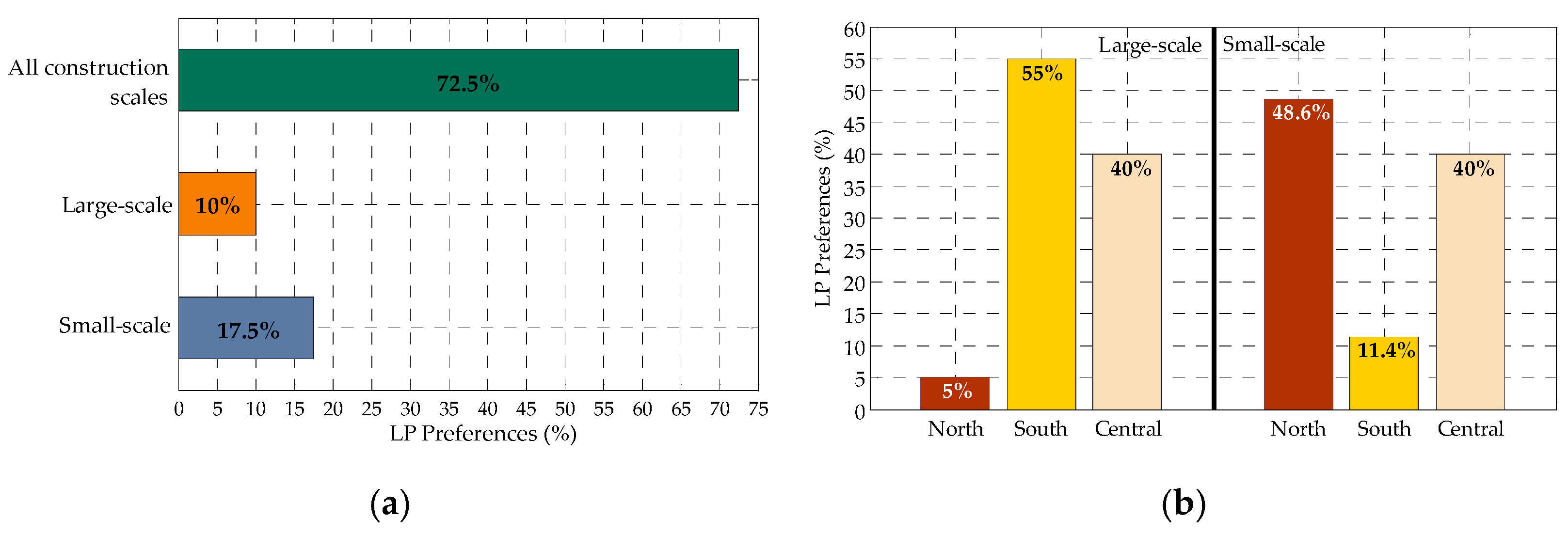
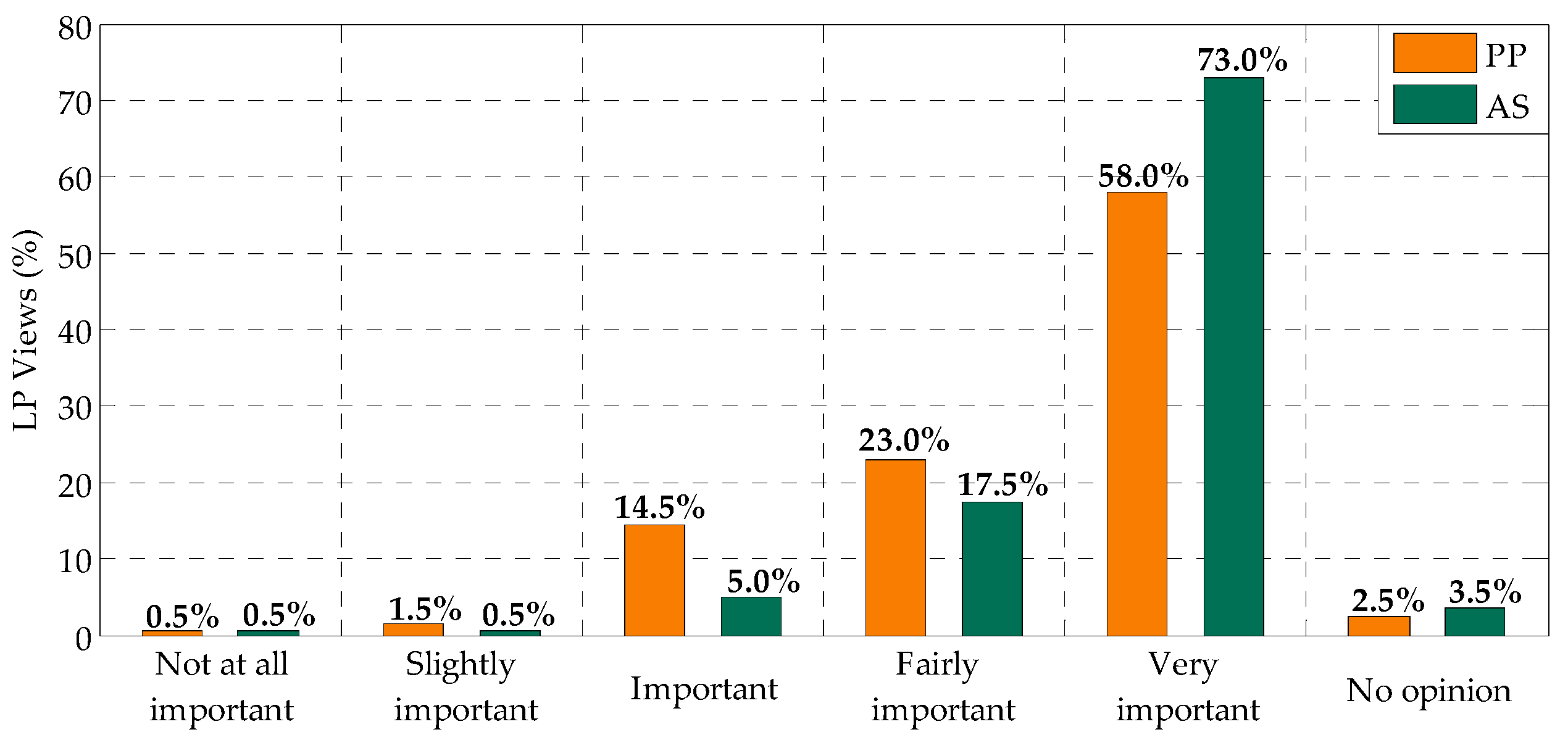
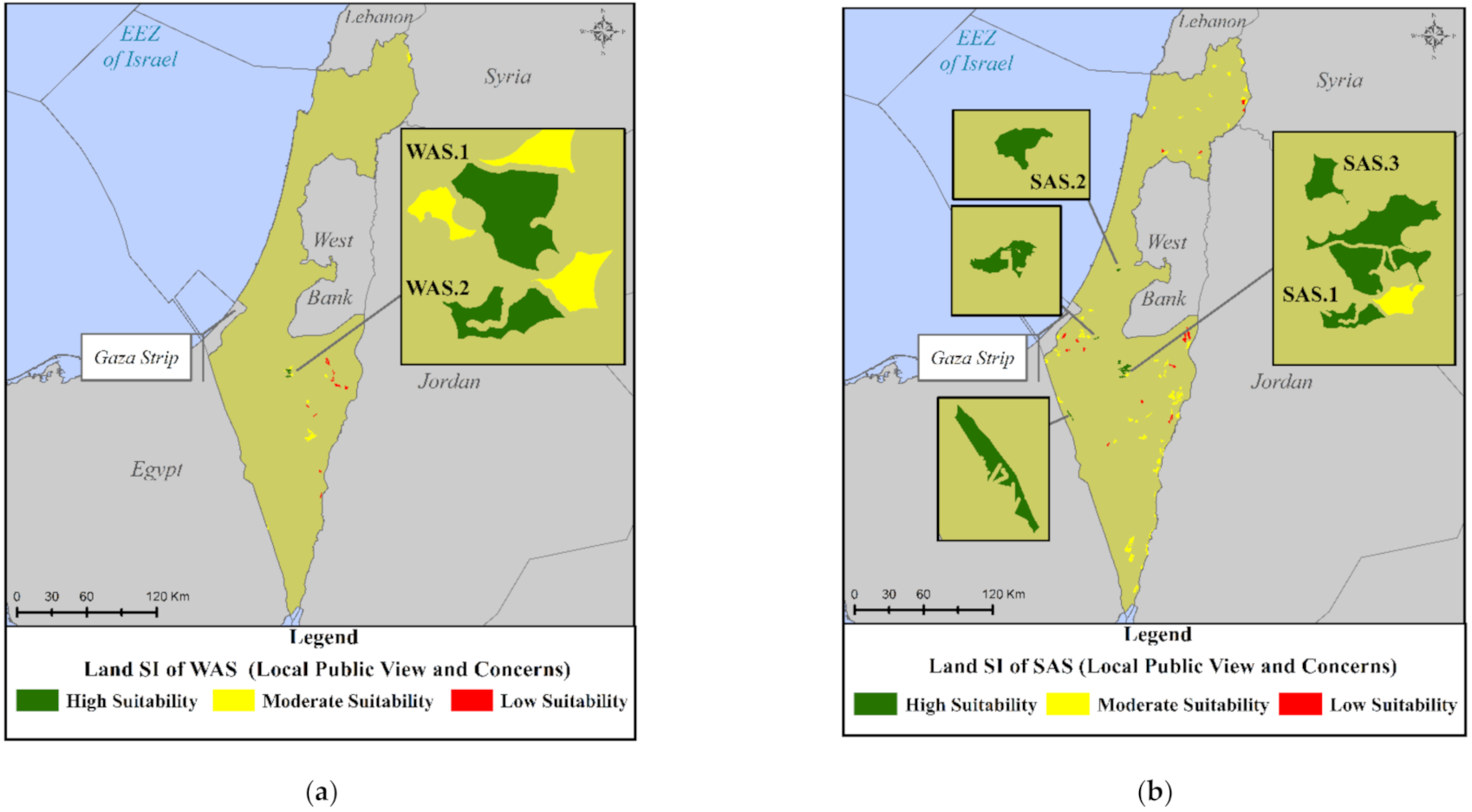
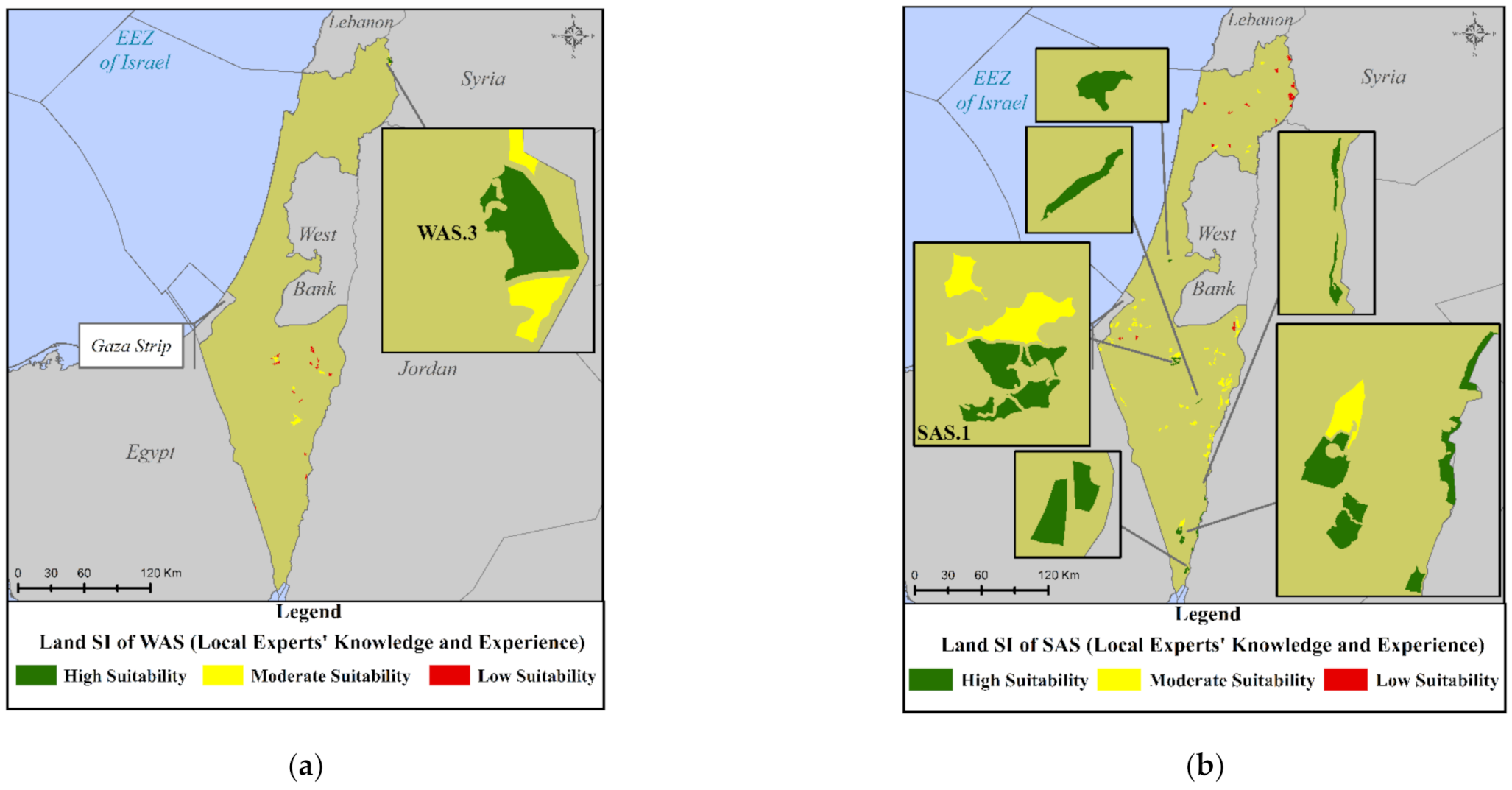
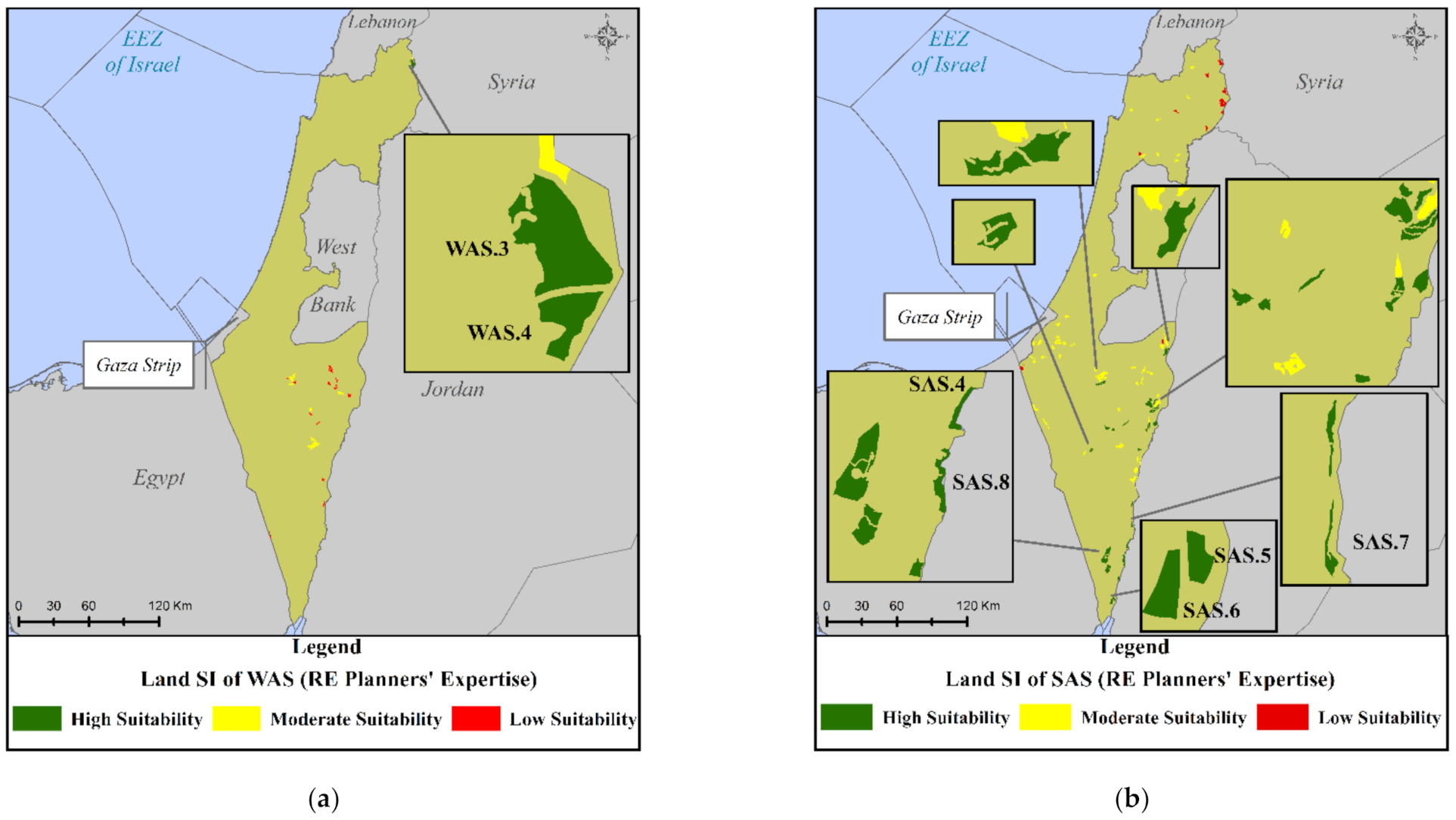
| SC No. | SC Name | GID No. | Data Process(es) | Data Source(s) |
|---|---|---|---|---|
| WSC.1 | Wind Velocity | GID.1 | Preprocessing | [52] |
| SSC.1 | Global Horizontal Irradiance (GHI) | GID.2 | Digitization | [53] |
| SSC.2 | Average Maximum Temperature | GID.3 | Digitization | [54] |
| WSC.2/SSC.3 | Slope of Terrain | GID.4 | Preprocessing | [55] |
| WSC.3/SSC.4 | Elevation | GID.4 | ||
| WSC.4/SSC.5 | Military Zones | GID.5 | Collection | [56,57,58] |
| WSC.7/SSC.8 | Distance from the Existing High-Voltage Electricity Grid | GID.5 | ||
| WSC.12/SSC.13 | Distance from Mineral Extraction Sites/ Quarrying | GID.5 | ||
| WSC.5/SSC.6 | Distance from the Existing Road Network | GID.6 | Collection and Digitization | [57,58,59,60] |
| WSC.6/SSC.7 | Distance from Railways Network | GID.6 | ||
| WSC.10/SSC.11 | Landscape Protection/Visual and Acoustic Disturbance | GID.6 | ||
| WSC.11/SSC.12 | Distance from Touristic Zones | GID.6 | ||
| WSC.13/SSC.14 | Distance from Economic Activities | GID.6 | ||
| WSC.14/SSC.15 | Distance from Archaeological, Historical, Cultural Areas | GID.6 | ||
| WSC.8/SSC.9 | Distance from Land Protected Areas, | GID.7 | Collection | [61] |
| WSC.17 | Distance from Important Bird Areas | GID.7 | ||
| WSC.9/SSC.10 | Distance from Civil and Military Aviation Areas | GID.8 | Digitization | [60,62,63] |
| WSC.15/SSC.16 | Distance from Water Areas | GID.9 | Collection and Digitization | [58,60] |
| WSC.16/SSC.17 | Distance from Coastline | GID.10 | Collection and Digitization | [60,64] |
| WSC.18/SSC.18 | Farm Minimum Required Area | GID.11 | Preprocessing | - |
| No. | Siting Criterion | Siting Aspect | Unsuitable Land Areas |
|---|---|---|---|
| WSC.1 | Wind Velocity | Economic | <5.0 m/s |
| WSC.2 | Slope of Terrain | Economic/Technical | >20% |
| WSC.3 | Elevation | Technical/Environmental | >2000 m |
| WSC.4 | Military Zones | Political | All |
| WSC.5 | Distance from the Existing Road Network | Economic/Technical/Social | ≤150 m and >10,000 m |
| WSC.6 | Distance from the Existing Railways Network | Technical/Social | ≤150 m |
| WSC.7 | Distance from the Existing High-Voltage Electricity Grid | Economic/Technical | ≤150 m and >30,000 m |
| WSC.8 | Distance from Land Protected Areas | Environmental | ≤500 m (environmental protected areas) |
| WSC.9 | Distance from Civil and Military Aviation Areas | Political/Technical | ≤2500 m |
| WSC.10 | Landscape Protection/Visual and Acoustic Disturbance | Social/Legal | ≤1900 m (urban and residential areas) ≤920 m (solitary residences) |
| WSC.11 | Distance from Touristic Zones | Social/Economic | ≤1100 m |
| WSC.12 | Distance from Mineral Extraction Sites/Quarrying | Technical/Restrictive | ≤100 m |
| WSC.13 | Distance from Economic Activities | Social/Technical | ≤500 m |
| WSC.14 | Distance from Archaeological, Historical and Cultural Areas | Social/Political | ≤1000 m (WHS) ≤500 m (rest cultural areas) |
| WSC.15 | Distance from Water Areas | Environmental/Social | ≤100 m |
| WSC.16 | Distance from Coastline | Environmental/Social | ≤500 m |
| WSC.17 | Distance from Important Bird Areas | Environmental | ≤500 m |
| WSC.18 | Farm Required Area | Economic | <2,500,000 m2 |
| No. | Siting Criterion | Siting Aspect | Unsuitable Land Areas |
|---|---|---|---|
| SSC.1 | GHI | Economic | <1600 kWh/m2/year |
| SSC.2 | Average Maximum Temperature | Economic/Technical | >40 °C |
| SSC.3 | Slope of Terrain | Economic/Technical | >5% |
| SSC.4 | Elevation | Technical/Environmental | >2000 m |
| SSC.5 | Military Zones | Political | All |
| SSC.6 | Distance from the Existing Road Network | Economic/Technical/Social | ≤150 m and >10,000 m |
| SSC.7 | Distance from the Existing Railways Network | Technical/Social | ≤150 m |
| SSC.8 | Distance from the Existing High-Voltage Electricity Grid | Economic/Technical | ≤150 m and >30,000 m |
| SSC.9 | Distance from Land Protected Areas | Environmental | ≤500 m (environmental protected areas) |
| SSC.10 | Distance from Civil and Military Aviation Areas | Political/Technical | ≤1000 m |
| SSC.11 | Landscape Protection/Visual and Acoustic Disturbance | Social/Legal | ≤800 m (urban and residential areas) ≤120 m (solitary residences) |
| SSC.12 | Distance from Touristic Zones | Social/Economic | ≤500 m |
| SSC.13 | Distance from Mineral Extraction Sites/Quarrying | Technical/Restrictive | ≤100 m |
| SSC.14 | Distance from Economic Activities | Social/Technical | ≤500 m (no buffer from Industrial Zones) |
| SSC.15 | Distance from Archaeological, Historical and Cultural Areas | Social/Political | ≤1000 m (WHS) ≤500 m (rest cultural areas) |
| SSC.16 | Distance from Water Areas | Environmental/Social | ≤100 m |
| SSC.17 | Distance from Coastline | Environmental/Social | ≤500 m |
| SSC.18 | Farm Required Area | Economic | <5,000,000 m2 |
| AC | Suitability Scaling | ||||
|---|---|---|---|---|---|
| 2 | 4 | 6 | 8 | 10 | |
| WAC.1 (m/s) | 5–6 | 6–7 | 7–8 | 8–9 | >9 |
| WAC.2 (%) | - | 15–20 | 10–15 | 5–10 | 0–5 |
| WAC.4 (km) | 20–30 | 15–20 | 10–15 | 5–10 | 0.15–5 |
| WAC.6 (km) | 0.5–1 | 1–2 | 2–3 | 3–4 | >4 |
| SAC.1 (kWh/m2/year) | - | 1816–2026 | 2026–2105 | 2105–2187 | 2187–2303 |
| SAC.2 (°C) | 28–29 | 27–28 | 26–27 | 25–26 | <25 |
| SAC.3 (%) | - | 4–5 | 3–4 | 2–3 | 0–2 |
| SAC.5 (km) | 20–30 | 15–20 | 10–15 | 5–10 | 0.15–5 |
| Site Characteristic | Field Investigation Process |
|---|---|
| Land use | On-site analysis |
| Distance from residential areas | On-site analysis and Google Earth Pro |
| Geographic boundaries and shape of the site | On-site analysis and Google Earth Pro |
| Proximity to road network | On-site analysis and Google Earth Pro |
| Slope of terrain | Google Earth Pro |
| Elevation | Google Earth Pro |
| Important bird areas | On-site analysis |
| Environmental protected areas | On-site analysis and Google Earth Pro |
| Touristic zones | On-site analysis |
| Archaeological, historical, and cultural areas | On-site analysis and Google Earth Pro |
| Land occupation | On-site analysis and Google Earth Pro |
| Suitability Analysis No. | RET | Participatory Group | Suitability Class | Suitability |
|---|---|---|---|---|
| 1 | WT | LP | High Suitability | 2 WAS (11.12%) |
| Moderate Suitability | 11 WAS (53.59%) | |||
| Low Suitability | 11 WAS (35.29%) | |||
| 2 | WT | LEs | High Suitability | 1 WAS (7.25%) |
| Moderate Suitability | 7 WAS (47.49%) | |||
| Low Suitability | 16 WAS (45.26%) | |||
| 3 | WT | REPs | High Suitability | 2 WAS (9.73%) |
| Moderate Suitability | 8 WAS (51.70%) | |||
| Low Suitability | 14 WAS (38.57%) | |||
| 4 | PV | LP | High Suitability | 8 SAS (10.49%) |
| Moderate Suitability | 63 SAS (72.82%) | |||
| Low Suitability | 16 SAS (16.69%) | |||
| 5 | PV | LEs | High Suitability | 16 SAS (19.53%) |
| Moderate Suitability | 54 SAS (63.29%) | |||
| Low Suitability | 17 SAS (17.18%) | |||
| 6 | PV | REPs | High Suitability | 28 SAS (35.17%) |
| Moderate Suitability | 47 SAS (51.85%) | |||
| Low Suitability | 12 SAS (12.98%) |
| No. | Participatory Group | Area (km2) | SI Value According to GIS |
|---|---|---|---|
| WAS.1 | LP | 12.32 | 6.32 |
| WAS.2 | LP | 5.57 | 6.32 |
| WAS.3 | LEs, REPs | 11.66 | 7.09, 7.54 |
| WAS.4 | REPs | 3.98 | 6.01 |
| SAS.1 | LP, LEs | 6.67 | 8.06, 7.20 |
| SAS.2 | LP | 6.25 | 7.26 |
| SAS.3 | LP | 7.85 | 7.15 |
| SAS.4 | REPs | 8.66 | 8.18 |
| SAS.5 | REPs | 5.14 | 7.37 |
| SAS.6 | REPs | 7.99 | 7.33 |
| SAS.7 | REPs | 5.21 | 7.19 |
| SAS.8 | REPs | 14.04 | 7.18 |
| Site No. | Main Field Investigation Process | Agreement between Field Data and GIS Results | Existence of Special Site-Specific Characteristics | Requirement forSI Update | Field Verified Site |
|---|---|---|---|---|---|
| WAS.1 | On-site analysis | Very good | Yes | Yes | No |
| WAS.2 | On-site analysis | Very good | Yes | Yes | No |
| WAS.3 | On-site analysis | Very good | Yes | No | Yes |
| WAS.4 | On-site analysis | Very good | Yes | No | Yes |
| SAS.1 | On-site analysis | Very good | Yes | Yes | No |
| SAS.2 | On-site analysis | Very good | No | No | Yes |
| SAS.3 | Google Earth Pro | Very good | Yes | No | Yes |
| SAS.4 | Google Earth Pro | Very good | No | No | Yes |
| SAS.5 | Google Earth Pro | Very good | No | No | Yes |
| SAS.6 | Google Earth Pro | Very good | Yes | No | Yes |
| SAS.7 | Google Earth Pro | Very good | No | No | Yes |
| SAS.8 | Google Earth Pro | Very good | No | No | Yes |
Publisher’s Note: MDPI stays neutral with regard to jurisdictional claims in published maps and institutional affiliations. |
© 2021 by the authors. Licensee MDPI, Basel, Switzerland. This article is an open access article distributed under the terms and conditions of the Creative Commons Attribution (CC BY) license (http://creativecommons.org/licenses/by/4.0/).
Share and Cite
Spyridonidou, S.; Sismani, G.; Loukogeorgaki, E.; Vagiona, D.G.; Ulanovsky, H.; Madar, D. Sustainable Spatial Energy Planning of Large-Scale Wind and PV Farms in Israel: A Collaborative and Participatory Planning Approach. Energies 2021, 14, 551. https://doi.org/10.3390/en14030551
Spyridonidou S, Sismani G, Loukogeorgaki E, Vagiona DG, Ulanovsky H, Madar D. Sustainable Spatial Energy Planning of Large-Scale Wind and PV Farms in Israel: A Collaborative and Participatory Planning Approach. Energies. 2021; 14(3):551. https://doi.org/10.3390/en14030551
Chicago/Turabian StyleSpyridonidou, Sofia, Georgia Sismani, Eva Loukogeorgaki, Dimitra G. Vagiona, Hagit Ulanovsky, and Daniel Madar. 2021. "Sustainable Spatial Energy Planning of Large-Scale Wind and PV Farms in Israel: A Collaborative and Participatory Planning Approach" Energies 14, no. 3: 551. https://doi.org/10.3390/en14030551
APA StyleSpyridonidou, S., Sismani, G., Loukogeorgaki, E., Vagiona, D. G., Ulanovsky, H., & Madar, D. (2021). Sustainable Spatial Energy Planning of Large-Scale Wind and PV Farms in Israel: A Collaborative and Participatory Planning Approach. Energies, 14(3), 551. https://doi.org/10.3390/en14030551







